
Author: Shahad Hossain
Shahad – Rent, Scenes from the Latin Quarter, and Opera
The book Scenes from a Latin Quarter and the movie Rent illustrated the Bohemian lifestyle and demonstrated similar themes of art, poverty, and love. However, I found the book to have dense language and hard to follow at times, so seeing those themes from the movie was more enjoyable. The movie’s flaw, in my opinion, is that it was a musical, so the music was a bit incessant at times, but it did a great job of capturing the Bohemian lifestyle. Also, the connections between the book and the movie were apparent because I read the book first and then watched the movie. So, when I saw similar themes, such as the characters failing to pay rent and the pride the artists took in their work, I could draw parallels between the book and the movie while watching. The movie also covered important topics for the Bohemian lifestyle in New York in the 1980s, such as Angel’s relationship with Collins and their suffering from AIDS. Back then, AIDS was thought only to be transferred between two men, and there weren’t as many treatment options available, meaning if you had contracted it, it was likely fatal. While researching the movie’s origins, I found that it was based on the opera La bohème, so going into watching the opera recordings, I was interested in drawing connections again. I thought the opera singers were talented and did a great job conveying emotion. I could see how the movie was based on an opera because of the similar ways of telling their stories through their voices. Overall, I enjoyed the book, the movie, the opera, and the connections they had between each other.
Shahad – Punk Rock
I don’t usually listen to punk rock, so when Rich Stremme’s songs were playing while we were drawing our graffiti, it was my first time listening to punk rock in a couple of years. I did not connect with the music or beats when listening, so I tuned it out while drawing, expecting not to be interested in his presentation. I was surprised when it was a Zoom presentation since I believed Rich would be there in person. In my opinion, all the technical difficulties made his presentation hard to follow and connect to. I did, however, enjoy listening to his experience with punk rock. I liked his discussion about zines, essentially small magazine pages intended to share a message to the public, and it was how punk rock artists spread their name. I have done a lot of graphic design work, making posters, campaigns, and websites, so it was interesting to hear about zines and how punk rock artists made their following. I thought it was crazy some of the lengths people went to because of punk rock, like how someone killed another person after getting kicked out of a rock show, and it showed me how passionate people were about punk rock back then. Rich’s presentation, although through Zoom, was easier to connect to because of the in-class items we could see, like the album covers being passed around the class, and I found them to teach me a bit more about the history of punk rock, which I liked. Although I don’t connect with punk rock music, it was interesting to hear about punk rock’s history and its specific terms like zines, which I think opened my eyes to punk rock.
Graffiti Art

Rabbit Play Blog @ Macaulay Central Building
Initially, I thought traveling to the Macaulay building to hear a play we had already read as a class would be a waste of time. However, I was excited to see the Macaulay building for the first time. After we entered the Macaulay building, we sat in a lounge area playing basketball legends on a computer, waiting for an actor stuck in traffic. Once the actor was ready, we entered the room to listen to the play. I saw the playwright in the back and a group of actors in the front preparing to read the play to us. As the actors started to read the play, I understood why it is important to hear it and not just passively read it. Hearing the narrative, the screams, and the emotions first-hand from the actors helped me to understand the play in a way I think just reading it would not provide. Although they only read the play from their voices and did not act it out as they would in an actual set, I determined the dynamics of each character, and the actors had the effect of setting the stage in a way that just reading it yourself would not have. The actors helped me understand what happened in this absurd situation where the man’s wife was birthing rabbits.
After the actors finished reading the play, I fully grasped its idea and message and saw the playwright’s idea as the artist behind it. The Q&A after the performance was also engaging as I heard the stories and passions behind each actor and artist who performed. I heard how the playwright handles misinterpretation, financial motives, and passion behind art. Most actors have actual day jobs and are not just full-time actors, which adds meaning to their art because they do it out of love alone since it is not how they make money. Furthermore, I thought the playwright would reject misinterpretation of his art, and how many of us thought it might have to do with pregnancy tests being done from rabbits in the 1970’s. However, he believed this interpretation was fine as everyone gets different meanings from the artist’s art, and as soon as art gets put out into the world it is open for everyone to see it as they see fit since it is not the artist’s possession anymore.
At first, I thought this trip would be a waste of time, straddling me away from other priorities; however, after the trip, I thought it was exciting to hear from the playwright and better understand the intention behind the play. Overall, I enjoyed the trip, and it was great to see the mindset behind the artist and learn more about art as a whole.
Night at The Museum
Going into the night at the museum I was physically exhausted from playing basketball for 3 hours. On the bus ride I took a short nap, however it was cut short, so I was not in the mood at all to visit a museum honestly. So, my opinion on the museum will probably be heavily influenced by how I felt going into it. The museum had a great entrance, and I think it certainly left an impression. Looking at the architecture I can already tell it had a lot of history behind it, and I was amazed by the design. However, that view was short lived as we entered, got welcome, and entered into the auditorium to hear the prepared presentation.
I don’t really remember much of the presentation because I was so tired and the man sitting next to me was a tank so I was distracted, but I did find the philosophical questions and the idea of “seeing” interesting. Oftentimes we hear a term so much we forget to think about what it means. A question like “what is a museum” made me think about what we were really visiting in the first place. I also remember the notion of “seeing” and really viewing the art piece before doing any research. It is easy to just quickly search up what an art piece means and move on, but frequently art is ambiguous so just trying to find one “correct solution” is incorrect when it comes to art.
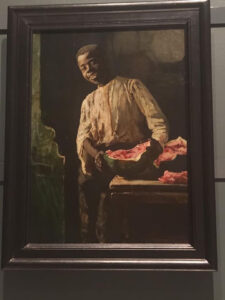
I Know’d it Was Ripe by Thomas Hovenden
This was the piece of artwork that caught most of my attention at the museum. For whatever reason I thought this painting was done recently. The realism caught my attention; it was almost like a photograph taken just yesterday of someone enjoying a watermelon. But, what changed the entire meaning of the painting for me was just the time period alone. This work by Thomas Hovenden was done in 1885, and if you know that time period you know the horrible atrocities being committed to African-Americans then. The boy’s happiness in the picture was a shock considering the history of the time. 1885 was post reconstruction America which is often called the Gilded age. In this period the Southern slave states returned to local control and we saw the rise of segregation policies in the form of Jim Crow laws. So, I thought his happiness may be a facade forced upon by the artist to capture an enthusiastic picture of the young black boy. However, I researched the painting and apparently the artist is actually in fact a black sympathizer since he was married to Helen Corson, who was a Quaker abolitionist. I am glad that his smile isn’t forced, but this painting may have had an unintended effect of showcasing that African-Americans were alright after the reconstruction era and simplified their suffering. Although I am sure the artist had no intention of doing so it may have had that effect during that time meaning that now when I look at the “happy painting” I almost feel sad because of the effects and time period it may have been taken in.
Overall although I was very tired, I enjoyed my trip to the museum and it was a lot of fun. I will say the art from this museum seemed more relevant to the time than the other museum visits we did so I was able to connect with the art more here. The artwork here, although sometimes simple in appearance, I think had a lot of meaning behind them and it was very enjoyable to try to find their meanings.
Snug Harbor Art Lab
Introduction:
My artistic ability when it comes to drawing, or painting is terrible. Unless I trace over some sort of already completed drawing, I can pretty much draw only well made stick figures and put random colors on a canvas. So, going into the art lab run by the Staten Island Museum, I expected to not really get how the art was drawn and find myself being lost in the room full of art. However Griselda, the person running the oil painting lab there, took us through a beginner crash course of oil paintings and was an amazing teacher as most of us were painting for the first time ever. I would say my experience at the art lab went better than expected as I created my first oil painting and learned a lot about how artists compose them.
Lecture & Painting:
Griselda told us the most challenging aspect of art is shaping the 2D world of a canvas into a 3D one. The artist has the responsibility of creating perspective within the canvas; the background having a lighter color to emphasize its presence and the foreground not overpowering the overall positioning of the art. She gave us a lot of useful tips such as starting with the background to make painting the foreground a lot easier, and also outlining our painting before even beginning. After her lecture on oil paintings, she set up everything to allow us to create our own paintings and we were given objects that we could choose from. I chose the fennel as the object since it was the most interesting to me, and I thought it seemed easy to draw. Just bits of splatters of green for the leaves and branches, and white for the base; however, it was a lot harder than I initially anticipated.
The funnel was placed within the perspective of a window and that’s what I imagined my painting to be. I wanted to have the window be within the perspective of the funnel and then have the funnel be the foreground of my painting. However, doing this as a beginner, was not a great idea. I started with the background of the clear sky, and the trees in the background, but then when I started painting the funnel it just blended in with my painting of the trees. So, within my painting you can’t really tell the difference between the foreground and the background and it just lost all perspective, which didn’t really turn out to be how I envisioned.
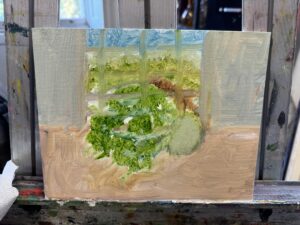
Picture of Funnel Painting
Conclusion:
It was fun to do my first oil painting at the art lab and it was therapeutic almost as I felt so relaxed after I finished my painting for some reason. It was also interesting to see how others painted the objects they chose; Aleksey’s and Kryistan’s paintings, in particular, did a really nice job of putting everything into perspective and you can clearly tell the objects they were attempting to paint. Looking back, my painting could’ve been a lot better if I just focused on painting the desk and the funnel, but what I pictured was the funnel getting a shining perspective from the window and the sky with the background having trees within it. So, I attempted to do so and although it didn’t come out as I expected, I definitely want to start painting more or just drawing in general. I used to draw a lot but I stopped, I think just before COVID so I want to start getting back into it again. Overall, it was a great experience and I learned a lot from Griselda and everyone there about oil painting, and it was great to sort of see the process for drawing the art and getting hands on with it.
The Counter Trip
Introduction:
My initial expectations of the counter were pretty high since I’ve been to broadway shows like spamalot in the past and they were amazing. Broadway shows have great acting, and really interesting stories so it’s always enjoyable to watch them. The counter was located in the roundabout theater and I had some worries about getting lost, but thankfully I didn’t miss the 1 train looking around wondering if I was at the right place (sorry Brendan.)
The Set:
Unfortunately we weren’t allowed to take pictures during the play, but before it started I was able to take one picture of the set. It was an interesting set as it appeared to be a small diner with the windows fogged up to showcase the cold environment it took place in. You can always tell when a character was going into a scene by the shadow of their figure through that window. Apart from that I was surprised at how small the set actually was; however, looking back the miniature sized set played into the intimacy and perspective of the show and it was perfect since there weren’t that many members of the cast.
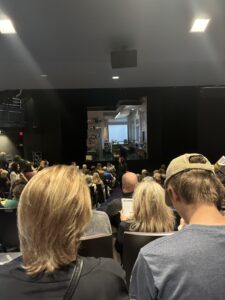
Picture of The Counter Set
The Characters:
In the cast, there weren’t a lot of background characters and people that don’t really add anything to the story. Every character that we were introduced to had a purpose to move the story along and it was refreshing not having to remember 20 different characters that don’t really serve a purpose into the main theme & story. The counter only starred Anthony Edwards as Paul, Susannah Flood as Katie, and Amy Warren as Peg. Paul was initially introduced as an alcoholic man who had trouble sleeping and seemed a little crazy, Katie just as the waitress with potential comedic relief, and Peg as the respected town Doctor. But, we learned about the specific intricacies of their relationships and stories later within the plot.
The Plot:
During the start of the show, I actually thought it was really boring, but during the exposition it actually started to get pretty interesting. Paul had mentioned that he wanted to become friends with Katie and she reluctantly accepted his request. They shared their darkest secrets with each other: Paul wanted his death to be a surprise, so he bought poison from the dark web and gave it to Katie, asking her to put it in his drink one day. Katie, on the other hand, spoke about her “boyfriend,” who had left 26 voicemails, and revealed that she had moved away because of her hysterectomy. Their relationship had an interesting dynamic because of its evolution overtime. At first, they were just a waitress and a frequent customer conversing, but by the end it seemed like they had a need for each other. The one day Paul didn’t come Katie had actually been worried about him as her routine of talking to him each day she worked was broken, meaning that she actually started to care about him.
Conclusion/Final Thoughts:
The ending was in my opinion terrible since it left off on a cliffhanger as Katie received another voicemail from her friend, where he mentioned that he had talked to her mother and moved closeby to meet her again, and Paul encouraged her to go to him as it wasn’t too late to take another chance at life. Paul and Katie said their final goodbyes and that was the end of the show. I realize I did leave a lot of details out like how Paul was in the peace corps, Paul saving a family from a fire, and how Paul had an affair with Peg, but I think the theme mainly revolved around Katie’s and Paul’s relationship so, I chose to sort of leave those out from the plot. Overall, I did end up enjoying the show, but it wasn’t really my type of show if I am being honest and the jokes they made were really dry, however the story was pretty interesting so it wasn’t the worst thing in the world.
Shahad Hossain – Berlin Wall Protest Art
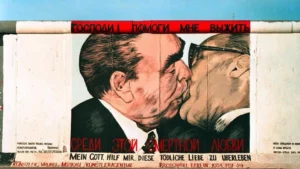
This photograph showcases a painting on the Berlin Wall titled “My God, Help me To Survive this Deadly Love” and it is a famous piece of graffiti by Dmitri Vrubel. The mural depicts a real-life moment from 1979 when the two Soviet leaders (USSR, & East Germany) kissed, which was a customary greeting to show a strong bond and affection between the communist leaders. This artist wanted to reflect the oppressive and strained nature of the Soviet-East German relationship, diguished as a partnership. This painting was painted shortly after the fall of the Berlin wall, symbolizing the end of the cold war; however, more modernly it captures the deep contradictions in political relationships, where the surface-level unity often hides the deeper forms of oppression and control. This artwork remains one of the most iconic symbols of Berlin and the reunification of Germany which, draws thousands of vistors today.
Trip to The Rubin by Shahad
Introduction:
This recent Saturday on 09/07/24 I had the pleasure of visiting the Rubin along with my friends Brendan, Danil, and Krystian. This was my first museum visit in a couple of years and so going into it I was influenced heavily by my predetermined notions from my previous museum visits. To me, or at least before this recent visit, I thought museums just contained ancient artifacts of art to gaze at and then leave shortly after having gathered enough information for the upcoming school project. But, my visit to the Rubin completely changed my perspective on museums and art (with a capital A as Lisa would say it) entirely.

Picture of Vast Bhutan by Asha Kama Wangdi
This was one of my favorite exhibits not necessarily because of its visual appeal but because of the meaning behind this piece. This piece is titled “Asha Kama Wangdi, Vast Bhutan” or the “Windhorse (Lungta)” and it is made of a collection of 40 years of littered polyester prayer mats that the artist had gathered to display in the Rubin; this massive piece extended from the first floor all the way to the sixth floor. For people that don’t know, polyester is a material that doesn’t dissolve naturally in nature, and so it harms the ecosystems where it is thrown out. The artist used this as inspiration and created this piece of fallen and faded prayer flags envisioned as the five “mad horses” because of the horrible environmental impact left by people.
I think that this piece perfectly demonstrates the idea that “art isn’t really Art without meaning” that we spoke of in class. For me personally at first, this wasn’t exactly visually appealing and I thought the piece was just a decoration in the middle of a spiraling staircase. But, when one of the workers explained the artists vision/intention behind the art piece I was intrigued by the deeper meaning that it possessed. So I think this helped, for me at least, to determine my own answer to what is Art? Additionally, it changed my perspective entirely on Art so it ended up becoming one of my favorite pieces in the museum.
EXHIBIT #2:
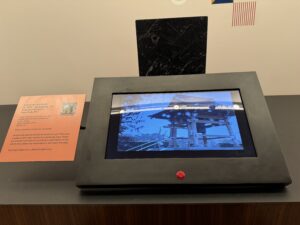
Scent created by Christophe Laudamiel
Joanin Temple for Mandala Lab, 2021
This is a part of an interactive art piece in the Mandala Lab in Rubin. This was another one of my favorite exhibits featured in the Rubin, because it extends the definition of Art itself. Within this piece you view a video of the featured piece, and then you can press on the red button to release the smell gathered from that specific place. In this case when I pressed on the red button it released the smell of the temple, which was my favorite out of I believe the five pieces that were there. I think this extends the definition of Art itself because it doesn’t just appeal to your visuals but also your sense of smell which inadvertently made me reimagine the possibilities that Art can have. What if art appealed to not only your eyes but also to each of the five senses that you have? Within this piece it also has a questionnaire before you view the actual place where the scent comes from, and then it gives you information as to how you “see” smell. So overall this was one of my favorite exhibits just because of how interactive it was and how you can also learn more about yourself as well.
EXHIBIT #3
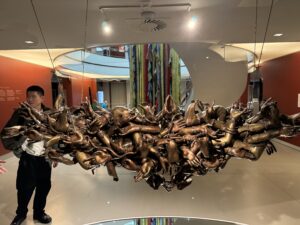
Picture of Muted Expressions 2022
Initially, I thought this art piece was just something nice to glance at and so I took this picture before knowing the true meaning behind it. Once I read the blurb which was hidden off to the side of the piece I was surprised by all the little details that I had missed. This piece was originally created in response to the devastating 2015 earthquakes in Nepal. Disembodied human hands and feet are put together in this piece, representing the inescapable nature of the earthquake in 2015. In the blurb I read I also found out that this sculpture also represents Buddhist concepts such as compassion, argument, prayer, and witnessing through the hand signals such as the “peace” and “rock on” signs. I didn’t think much of this piece until I saw the meaning behind it and so I think that connects, once again, to the notion that art isn’t really Art without an underlying message behind it.
CONCLUSION:
Overall, I really enjoyed my visit to the Rubin as it changed my perspective on what Art is and what Art can be. My visit was a lot more interactive than I thought it would be, and I was surprised by the messages behind some of the pieces featured there. Unfortunately this place is closing sometime in October, but I am glad I was able to have the Art featured here. It’s also crazy to think that their location in New York only features 3% of their entire collection featured throughout the world, and so I am intrigued to research some of the other pieces featured at some of the other spots internationally. Honestly going into it I expected to be bored by the pieces there since I am not a “Museum” or an “Art” person but, I was genuinely intrigued by the Artwork at the Rubin. So, the next time I visit a museum I think I will be a lot more open minded and try to find the meaning behind the artwork before judging the quality based on appearances.

